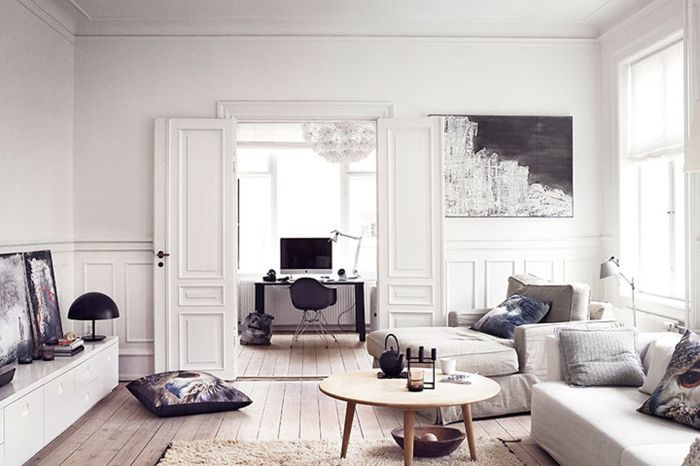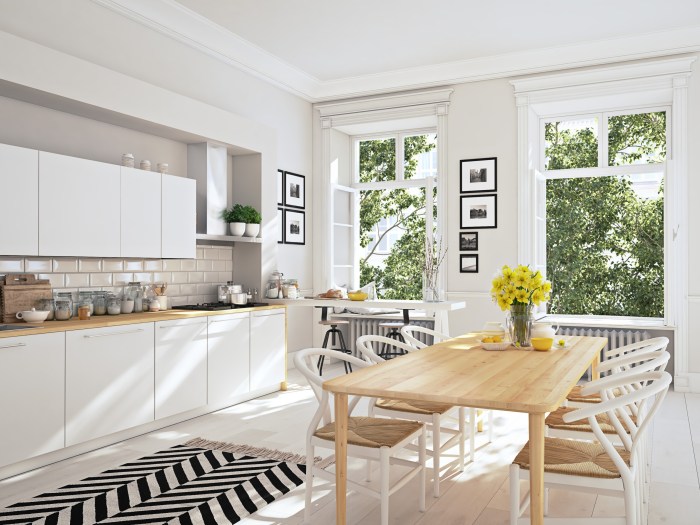Exploring Scandinavian Interior Design: A Guide to Elegance and Simplicity

Embark on a journey through the world of Scandinavian interior design, where elegance meets simplicity in a harmonious blend of functionality and style. From the soothing color palettes to the cozy textures, each element plays a crucial role in creating spaces that are both aesthetically pleasing and practical.
Let's delve into the key aspects of this timeless design aesthetic.
Scandinavian interior design is renowned for its minimalistic approach, clean lines, and focus on natural elements. This design style emphasizes creating bright, airy spaces that invite warmth and comfort.
Characteristics of Scandinavian Interior Design

Scandinavian interior design is known for its minimalist and functional approach, emphasizing simplicity and clean lines to create spaces that are both aesthetically pleasing and functional.
Color Palette
Scandinavian interiors typically feature a neutral color palette, with shades of white, beige, grey, and soft pastels dominating the design. These light colors help to reflect natural light and create a sense of airiness and spaciousness in the room.
Emphasis on Natural Light
Natural light plays a crucial role in Scandinavian interior design, with large windows and light curtains allowing sunlight to flood the space. The use of light colors on walls and furniture further enhances the brightness of the room, creating a warm and inviting atmosphere.
Minimalist Furniture and Clean Lines
Scandinavian interiors often showcase minimalist furniture pieces with clean lines and simple designs. Functionality is key, with furniture serving a practical purpose while also contributing to the overall aesthetic of the space. This design approach helps to create a clutter-free environment that promotes relaxation and a sense of calm.
Materials and Textures in Scandinavian Interior Design
Scandinavian interior design is known for its use of specific materials and textures that contribute to its signature aesthetic.
Light-Colored Woods: Pine and Beech
In Scandinavian interior design, light-colored woods like pine and beech are commonly used in furniture. These woods help create a sense of airiness and brightness in the space, reflecting the natural light that is essential in Scandinavian design.
Natural Materials: Wool, Leather, and Fur
Natural materials play a significant role in Scandinavian interior design, with a focus on sustainability and connection to nature. Wool, leather, and fur are often incorporated into decor to add warmth and texture to the space.
Textures: Knits and Sheepskins
To enhance the feeling of warmth and coziness in Scandinavian interiors, textures like knits and sheepskins are commonly used. These elements not only add visual interest but also provide a tactile experience that invites people to relax and feel at home.
Functionality and Practicality in Scandinavian Interior Design
In Scandinavian interior design, functionality and practicality are key aspects that heavily influence the furniture design and layout of spaces.
Focus on Functionality in Furniture Design
In Scandinavian interior design, furniture is not only chosen for its aesthetic appeal but also for its functionality
The Concept of "Hygge" and its Influence on Space Layout
"Hygge" is a Danish concept that embodies coziness, comfort, and a sense of well-being. In Scandinavian interior design, the concept of "hygge" heavily influences the layout of spaces. Rooms are designed to promote a feeling of warmth and intimacy, with comfortable furniture arrangements, soft lighting, and natural elements that create a cozy atmosphere.
Organization Solutions and Multi-functional Pieces
Scandinavian interior design often incorporates smart organization solutions like storage furniture and multi-functional pieces. Storage is cleverly integrated into furniture design to maximize space and reduce clutter. Multi-functional pieces, such as convertible sofas or dining tables with storage compartments, offer versatility and practicality in small living spaces.
Elements of Nature in Scandinavian Interior Design

Nature plays a significant role in Scandinavian interior design, bringing a sense of calmness and connection to the outdoors into the home.
Indoor Plants and Botanical Elements
Indoor plants are a common feature in Scandinavian interiors, adding a touch of greenery and life to the space. From small succulents to large leafy plants, incorporating nature indoors creates a fresh and vibrant atmosphere.
Natural Motifs in Decor
Scandinavian interior design often includes natural motifs such as tree branches, leaf patterns, and animal prints in decor elements like throw pillows, rugs, and artwork. These motifs add a sense of organic beauty and harmony to the space.
Connection to the Natural Environment
The use of natural elements in Scandinavian interior design is rooted in the region's deep connection to the natural environment. By bringing elements of nature indoors, it not only enhances the aesthetics of the space but also has a positive impact on well-being.
Studies have shown that exposure to nature, even in interior design, can reduce stress levels and improve overall mood and productivity.
Final Wrap-Up
In conclusion, Scandinavian interior design offers a unique fusion of beauty and practicality, where every element serves a purpose in enhancing the overall ambiance of a space. By incorporating natural textures, light colors, and functional furniture, this design aesthetic continues to captivate admirers worldwide with its timeless appeal.
FAQ Summary
What are the typical colors used in Scandinavian interior design?
Soft hues like whites, grays, and pastels are commonly used to create a serene and airy atmosphere in Scandinavian interiors.
How does the concept of "hygge" influence Scandinavian interior design?
Hygge, a Danish term representing coziness and contentment, influences the design by emphasizing warmth, comfort, and creating inviting spaces for relaxation.
What natural materials are frequently incorporated in Scandinavian decor?
Natural materials like wood, wool, leather, and fur are often used to add warmth and texture to Scandinavian interiors, enhancing their cozy appeal.

